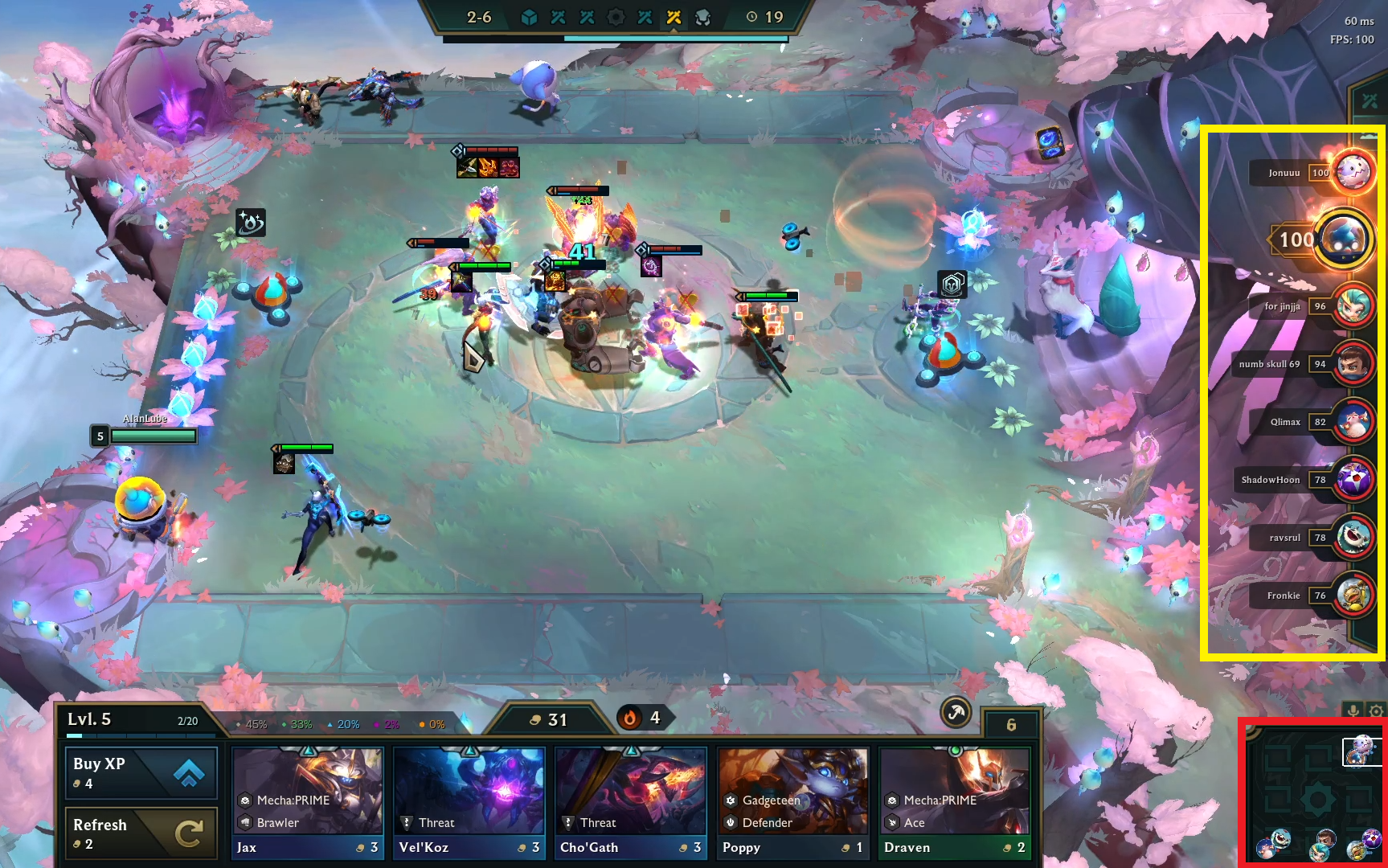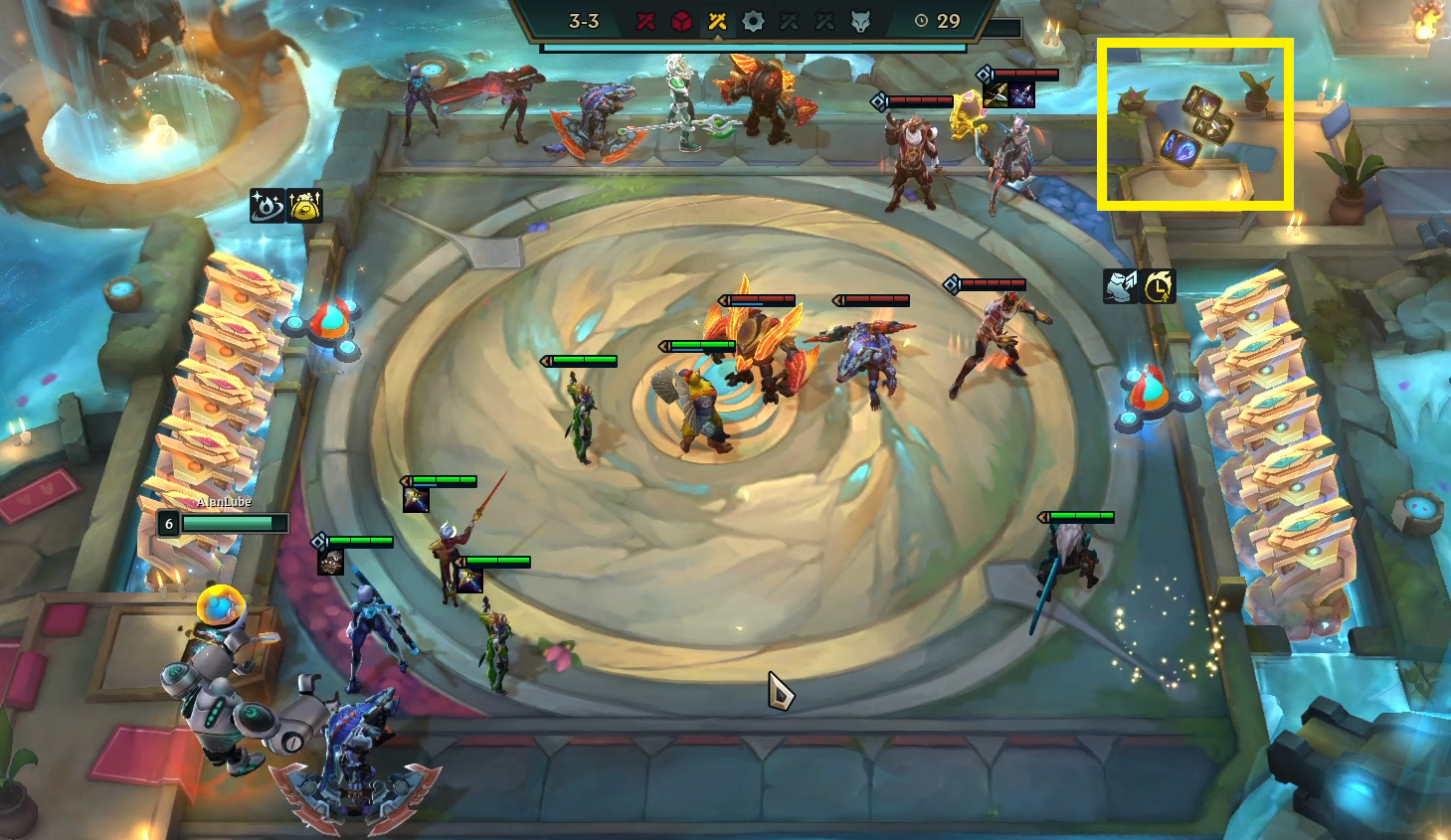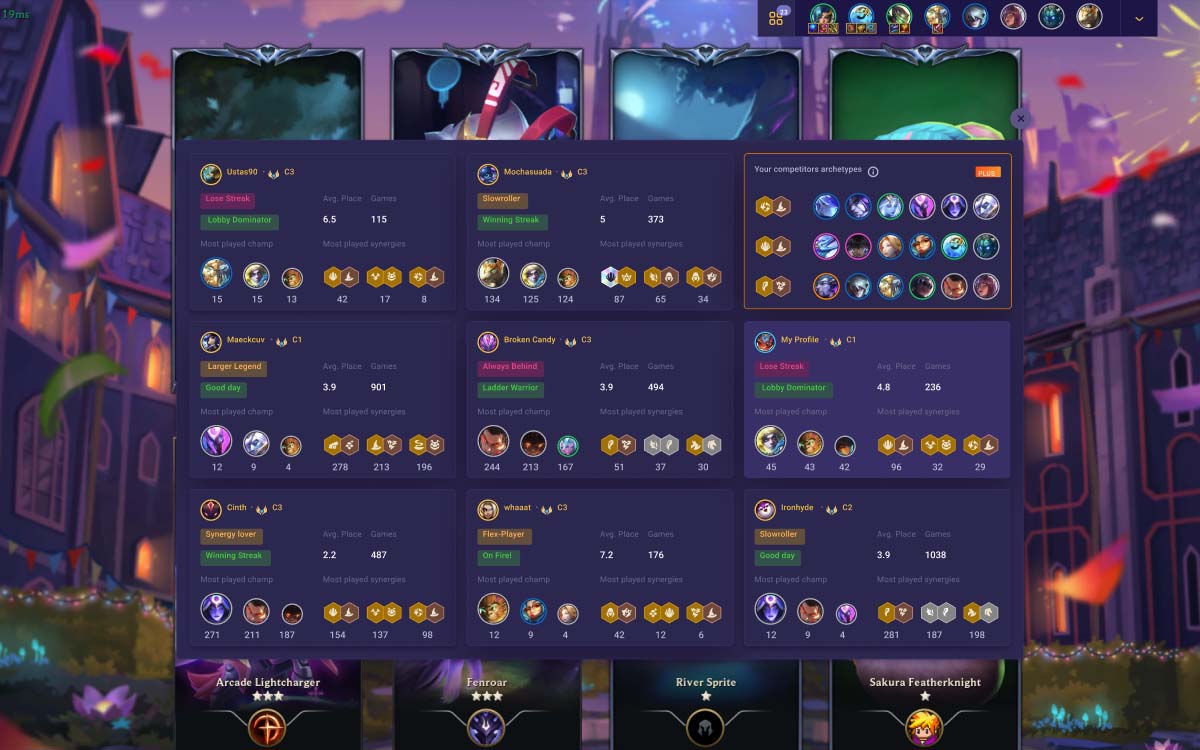The Art of Scouting in TFT
TFT is a highly complex game in which very many small decisions can greatly affect the outcome of your game. Things like positioning, itemization, and scouting are all examples of small decisions that will greatly increase your team’s effectiveness throughout the game. In this guide, we will take an in-depth look at scouting, and how you can improve your climb by simply taking the time to scout out enemy boards.
What is scouting in TFT?
Scouting in TFT refers to looking at the boards of enemy players to adjust your gameplan. This adjustment can come with itemization, positioning, or deciding on your team comp. To do so, you can click on the player portraits to check on enemy boards specifically, or you can use hotkeys.
- 1/Q – Scout the next player in clockwise fashion.
- 3/R – Scout the next player in counter-clockwise fashion.
- 2/Space – Center Camera on Little Legend
Note: Using Hotkeys will cycle through based on the mini map on the bottom right (Red). Clicking on player portraits will allow you to see the board of any player you want (Yellow), which you may want to do based on health.
In Game Scouting Tool
Since the release of Set 6.5, TFT has added an in game feature that allows you to see which player you may face in the next round. Early in the game, this may include every player in the lobby. As the game progresses, there may be rounds where you will know for sure who you will face.
On the right side of the screen, next to the player portraits, there will be a small indicator to show this.
Why is scouting important?
For many players climbing in Silver or Gold, scouting can be a luxury that you will save until the endgame to specifically counter enemy positions, but many of the top players scout many times throughout the match to constantly adapt to what they see.
While you may not be able to extract as much information as top Challenger players, over time, as you practice scouting, you will be able to find the pieces of information that will be useful to you quicker, allowing you to put yourself in the best position to either win the game, or play for a top 4 spot.
The Scouting Paradox
Many times, you will notice that a lot of the top players scout very sporadically. Some games they may scout many times, and other games almost none at all. This comes from pure experience as once you become accustomed to positioning, itemization, etc, it can be easier to play without scouting. So while scouting can be quite important, there possibly will come a point where scouting is less necessary as you accustom yourself to the meta.
Even still, it should come as no surprise that scouting will almost never be a detriment, unless you don’t give yourself enough time to do other important things like buying units or changing position.
When should you scout?
Scouting effectively can be quite difficult for players who are not accustomed to scouting. Even still, if you have a round where you aren’t buying any units, and you have an extra 20 seconds before you watch your board fight, take that time to take a quick peek at everyone’s board to at least learn something about the state of your lobby.
If you have any extra time, you can take that time to scout instead of waiting around. Lastly, don’t forget to take a quick look at the items of whoever you are fighting.
It’s easy to look at the units you are directly fighting, but also looking at the items they have can help you envision their plan, which will allow you to adjust your own game plan, or even steal the item they want from the carousel.
Pre Game Scouting – What will others play?
If you don’t already have our in game app, be sure to check it out and download it here. With our app, we are able to show a pre game scouting feature that will let you know what your opponent is likely to play.
With this feature, you’ll be able to see what champions and traits your opponents are likely to play. With this information, you can see what comps to avoid during your game. However, even if your opponent spams one comp, that doesn’t mean they are guaranteed to play it.
This feature will simply help you get a small understanding of what is likely to happen, and you can adjust your game plan accordingly.
Early Game Scouting – Should you Slow Roll?
Slow Roll decisions are one of the best early examples of scouting. Let’s say you want to play a slow roll comp like Camille. You may find an early Camille 2, and decide to play this comp. However, if you scout around and find 2 or even 3 other players with Camille, you may want to play a different comp.
You could commit anyway and hope other players pivot, or hold hands together to the bottom of the lobby, but that is a decision you can make after scouting.
This form of scouting is quite quick as you simply need to count the amount of enemies that are holding the units you want, as well as count how many units they have already.
You should also see what items they have as that is another indicator of how likely they will continue playing a certain comp.
Mid Game Scouting – Understand what players are committing to
This is the area in which most players aren’t sure what to look for. It can be quite difficult to find the time to scout when you are planning your build and are unsure what units to put in. As a result, the mid game can become much easier if you know what build you are going for as well as what units you plan on putting in.
The more experience you have playing a build, the faster you will be able to make decisions, resulting in more time leftover for you to scout. The mid game from after Krugs to Wolves is where most players will be committing to whatever build they plan on going, so that moment is a good time to look at what they have to adjust your game plan.
Things to look out for
What type of damage are most players in the lobby building?
If you see that most players are playing assassins or mages, you can plan your items accordingly to counter them. For example, Dragon’s Claw will help against mages and Bramble Vest will help against assassins.
What are the strongest players in the lobby playing?
If you find yourself in the middle of the pack, you should try and figure out what enemy teams will likely defeat yours. With this knowledge, you can reposition your board to hopefully minimize the damage you will take if you face them.
Simply moving your carry a few hexes to ensure they don’t get jumped on by a Hacker can help save that slight bit of HP you need to crack top 4 later in the game.
What items do enemies have on their units or on their bench?
If you have enough time, items can be a great indication of what players are capable of building into. If you see lots of players building Bramble Vest, you may want to prioritize a Last Whisper.
You can also check the items that have already been built by players to assume which carry they are going for. If someone has built very specific items like
Spear of Shojin + Jeweled Gauntlet, you can very safely assume they are going to play Taliyah, Miss Fortune, or a similar AP carry.
How much HP and Gold do other players have?
Player gold and health can be a great indicator as to what decisions people will make in the near future. For example, if someone has low health and a lot of gold right before a neutral creep round, it is safe to assume that they will all in after creeps.
If they happen to be going for the same build as you, you might decide to roll sooner to find the units first. You might decide that their build has a favorable matchup against yours, so you may want to reposition your board to counter theirs instead.
Conversely, if you find that you lost to a board while the enemy has no gold, you can safely see that they already went all in, and with this knowledge, you can safely determine whether or not they will be a threat after you use up your gold and resources.
Late Game Scouting – Play for small advantages
Late game scouting is one of the most common scouting times as there are less players to look at during this time. These are the times when you should position your board to directly counter the player or players that you didn’t beat previously, but might be able to if you safely protect your carries, or spread out your units to avoid enemy CC.
We won’t go in-depth into positioning here as it will require an entire guide of its own, but these general tips can be followed:
- Position your carries away from where assassins will jump, either on the opposite side or in the middle.
- Putting your carry on the opposite side will run the risk of your enemy also repositioning, so watch out for that.
- Spread out your units for teams that have area of effect damage or CC. Units like Braum or Lux can be reduced in strength if you position your team to ensure that they don’t hit your entire team during the fight.
- WATCH FOR ZEPHYR. Zephyr is one of the late game items that can entirely determine the fight if they manage to land it on one of your main carries.
Additional Scouting Tips and Tricks
Carousel Sniping
If you know what item or champion your enemy desperately needs, you can choose to pick that up from the late game carousel if you yourself don’t have an item or champion that you need more. This can stop a Urgot 2 or Fiddlesticks 2 from destroying your team while you weren’t paying attention.

Zephyr
I briefly mentioned Zephyr previously, but also know that if you find a Zephyr from the late game carousel, you can ensure you land it on their main carry if you wait until right before the fight starts to place your Zephyr. This ensures that they can’t move their carry and you can snipe them with Zephyr at the last second. Note that this will only work once, and make sure whatever you are trying to snipe isn’t in the Zephyr spot of a champion you have with full items.

- In this example, I want to Zephyr his Kha’Zix, so I wait until right before the round starts to place my Zephyr on my bottom right unit. Had I placed it earlier, he could have moved his Kha’Zix at the last second.
Hold contested units
If it’s early in the game and you have extra gold beyond your interest level, you can spend your extra gold to hold units that you know enemies want.
In the early game, this can be Katarina or Scrap units that you don’t need. In the late game, you can look to hold 5 cost units that many players are looking for or 4 cost units they are trying to 3 star.
Adapt accordingly as players die
If you are looking for the last Kai’Sa you need for 2-star or the last Lux you need for 3-star, you might decide to wait until the player with a 2-star Kai’Sa/Lux dies first so that you have a better chance of finding them when you roll down.
This comes with predicting whether or not the enemy player will die before you do, so make sure that factor that into your decision.
Scouting check list (quick rundown of things to look out for)
Early game
- Should I slow roll?
- Check enemy units
- Check enemy items
- (Who’s going for Katarina?)
- What items have people built?
- Zephyr?
Mid Game
- What damage types are people building?
- Itemize accordingly
- Should I clump my board or spread out for CC units?
- Assassins or AoE?
- Who do I lose against?
- (Counter position accordingly)
- Once again, enemy items/units.
- ZEPHYR
- Plan build ideally for less contested units.
- Not always possible but try to
Late Game
- What high-cost units do people need?
- Take them yourself
- What items do people need?
- Steal them from the carousel
- Position specifically against certain enemies you haven’t fought in a while
- In top 3, play the odds and position against the enemies alternating, note that the ghost board will be random.
- Where are the Zephyrs?
- Are other players holding my units?
- (If so maybe eco to 9 or wait until they die to roll.)
If you follow each of these steps and questions throughout the game, you are sure to increase your win rate or top 4 rate by a large margin compared to never scouting.
Conclusion
Scouting is a very necessary part of the game, and some high elo players scout very consistently while some only do sparingly. As explained, scouting will never hurt your chances, but sometimes just watching your own board fights can give you a strong enough idea of how the lobby is going.
That being said, those who do take that extra step to scout other boards can truly make min/max decisions that might alter their placement as a result. Scouting can be tough to integrate into every match you play, but taking small steps will very likely result in less tilt and better decision making, ultimately allowing you to climb the ranks faster and with a better win rate.
Thanks for reading our TFT scouting guide! Be sure to check out site for recommended team comps, champ tier list, and item tier list to help you stay on top of the meta.
To learn about the latest TFT Set 8, head to our all-in-one Teamfight Tactics Set 8 reveal page that covers all champions, synergies, and more!
Subscribe to our newsletter:
Don’t miss out on all of the latest TFT content!
 Download APP
Download APP Collapse
Collapse







